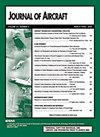Meshless Large-Eddy Simulation of Propeller–Wing Interactions with Reformulated Vortex Particle Method
IF 2.1
3区 工程技术
Q2 ENGINEERING, AEROSPACE
引用次数: 0
Abstract
The vortex particle method (VPM) has gained popularity in recent years due to a growing need to predict complex aerodynamic interactions during the preliminary design of electric multirotor aircraft. However, VPM is known to be numerically unstable when vortical structures break down close to the turbulent regime. In recent work, the VPM has been reformulated as a large-eddy simulation (LES) in a scheme that is both meshless and numerically stable without increasing its computational cost. In this study, we build upon this meshless LES scheme to create a solver for interactional aerodynamics. Propeller blades are introduced through an actuator line model following well-established practices for LES. A novel, vorticity-based actuator surface model (ASM) is developed for wings, which is suitable for propeller–wing interactions when a wake impinges on the surface of a wing. This ASM imposes the no-flow-through condition at the airfoil centerline by calculating the circulation that meets this condition and by immersing the associated vorticity in the LES following a pressure-like distribution. Extensive validation of propeller–wing interactions is presented by simulating a tailplane with tip-mounted propellers and a blown wing with propellers mounted midspan.用重新制定的涡流粒子法对螺旋桨与机翼的相互作用进行无网格大埃迪模拟
近年来,由于在电动多旋翼飞行器的初步设计过程中越来越需要预测复杂的气动相互作用,涡旋粒子法(VPM)越来越受欢迎。然而,众所周知,当涡旋结构在接近湍流状态时破裂,VPM 在数值上会不稳定。在最近的工作中,VPM 已被重新表述为一种大涡流模拟(LES)方案,该方案既无网格又具有数值稳定性,同时还不会增加计算成本。在本研究中,我们以这种无网格 LES 方案为基础,创建了交互式空气动力学求解器。螺旋桨叶片是通过执行器线模型引入的,该模型采用了成熟的 LES 方法。为机翼开发了一种新颖的、基于涡度的致动器表面模型(ASM),该模型适用于螺旋桨与机翼之间的相互作用(当尾流撞击机翼表面时)。该 ASM 通过计算满足该条件的环流,并将相关涡度按照压力分布浸入 LES 中,从而在机翼中心线上实现无穿流条件。通过模拟带尖端安装螺旋桨的尾翼和带中跨安装螺旋桨的吹翼,对螺旋桨与机翼的相互作用进行了广泛验证。
本文章由计算机程序翻译,如有差异,请以英文原文为准。
求助全文
约1分钟内获得全文
求助全文
来源期刊

Journal of Aircraft
工程技术-工程:宇航
CiteScore
4.50
自引率
31.80%
发文量
141
审稿时长
6 months
期刊介绍:
This Journal is devoted to the advancement of the applied science and technology of airborne flight through the dissemination of original archival papers describing significant advances in aircraft, the operation of aircraft, and applications of aircraft technology to other fields. The Journal publishes qualified papers on aircraft systems, air transportation, air traffic management, and multidisciplinary design optimization of aircraft, flight mechanics, flight and ground testing, applied computational fluid dynamics, flight safety, weather and noise hazards, human factors, airport design, airline operations, application of computers to aircraft including artificial intelligence/expert systems, production methods, engineering economic analyses, affordability, reliability, maintainability, and logistics support, integration of propulsion and control systems into aircraft design and operations, aircraft aerodynamics (including unsteady aerodynamics), structural design/dynamics , aeroelasticity, and aeroacoustics. It publishes papers on general aviation, military and civilian aircraft, UAV, STOL and V/STOL, subsonic, supersonic, transonic, and hypersonic aircraft. Papers are sought which comprehensively survey results of recent technical work with emphasis on aircraft technology application.
 求助内容:
求助内容: 应助结果提醒方式:
应助结果提醒方式:


